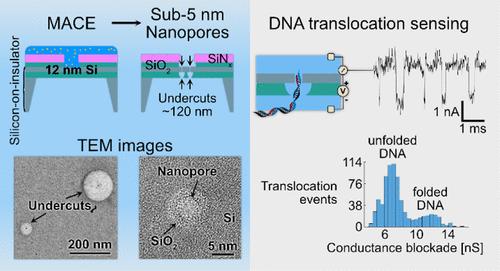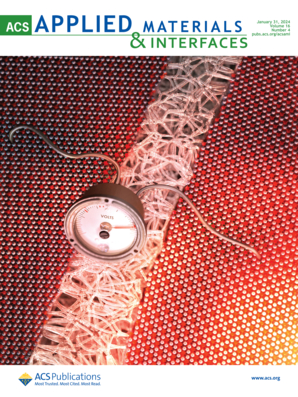Sub-5 nm Silicon Nanopore Sensors: Scalable Fabrication via Self-Limiting Metal-Assisted Chemical Etching
IF 8.3
2区 材料科学
Q1 MATERIALS SCIENCE, MULTIDISCIPLINARY
引用次数: 0
Abstract
Solid-state nanopores offer unique possibilities for biomolecule sensing; however, scalable production of sub-5 nm pores with precise diameter control remains a manufacturing challenge. In this work, we developed a scalable method to fabricate sub-5 nm nanopores in silicon (Si) nanomembranes through metal-assisted chemical etching (MACE) using gold nanoparticles. Notably, we present a previously unreported self-limiting effect that enables sub-5 nm nanopore formation from both 10 and 40 nm nanoparticles in the 12 nm thick monocrystalline device layer of a silicon-on-insulator substrate. This effect reveals distinctive etching dynamics in ultrathin Si nanomembranes, enabling precise control over nanopore dimensions. The resulting nanopore sensor, suspended over self-aligned spheroidal oxide undercuts with diameters of just a few hundred nanometers, exhibited low electrical noise and high stability due to encapsulation within dielectric layers. In DNA translocation experiments, our nanopore platform could distinguish folded and unfolded DNA conformations and maintained stable baseline conductance for up to 6 h, demonstrating both sensitivity and robustness. Our scalable nanopore fabrication method is compatible with wafer-level and batch processing and holds promise for advancing biomolecular sensing and analysis.

求助全文
约1分钟内获得全文
求助全文
来源期刊

ACS Applied Materials & Interfaces
工程技术-材料科学:综合
CiteScore
16.00
自引率
6.30%
发文量
4978
审稿时长
1.8 months
期刊介绍:
ACS Applied Materials & Interfaces is a leading interdisciplinary journal that brings together chemists, engineers, physicists, and biologists to explore the development and utilization of newly-discovered materials and interfacial processes for specific applications. Our journal has experienced remarkable growth since its establishment in 2009, both in terms of the number of articles published and the impact of the research showcased. We are proud to foster a truly global community, with the majority of published articles originating from outside the United States, reflecting the rapid growth of applied research worldwide.
 求助内容:
求助内容: 应助结果提醒方式:
应助结果提醒方式:


